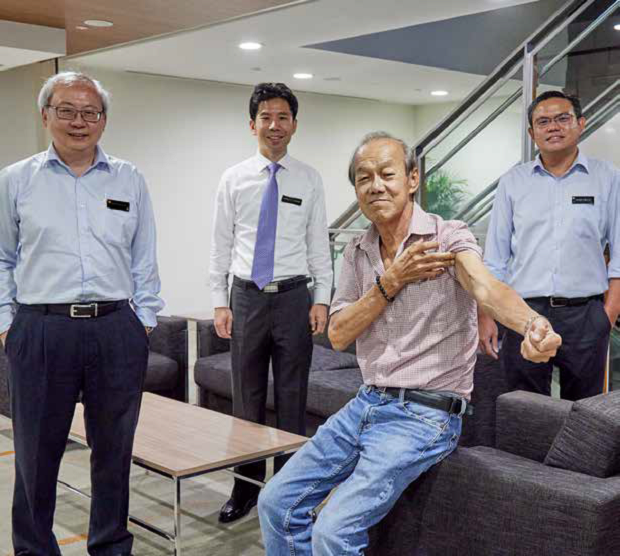
Fistula created by new keyhole procedure lasts longer, needs less maintenance.
Patients with end-stage kidney failure typically undergo surgery to create a fistula in the arm before haemodialysis can start. They face scarring, a potential failure of the vascular access to mature, and frequent narrowing of the veins, which then requires balloon angioplasty.
Under a Singapore General Hospital (SGH)-led pilot, however, patients can undergo a keyhole procedure to create the fistula — the connection between a vein and an artery. During haemodialysis, two needles are inserted into the fistula to allow blood to flow through the dialysis machine and clean the blood of wastes and toxins.
“The endovascular arteriovenous (endoAVF) fistula has no scar, has a very high success rate of 90 per cent, and requires little maintenance,” said Associate Professor Tan Chieh Suai, Senior Consultant and Head, Department of Renal Medicine, SGH.
The ability of the fistula vein to grow and thicken enough for blood to flow properly with the conventional method is 50 to 70 per cent worldwide, and 90 per cent with endoAVF. Still, some 60 per cent of patients will require balloon angioplasty to enlarge the blood vessel to keep the fistula working over time. Previously, patients may undergo angioplasty twice or thrice a year. With endoAVF, it is likely that this will be reduced to once in two years.
“We see endoAVF benefits, not just to the patients, but also the system, in that it may reduce the cost of recurrent angioplastry procedures. A minimally invasive procedure is always attractive to patients, as it leaves no scar, has less downtime and less complications,” said Associate Professor Chong Tze Tec, Senior Consultant and Head, Department of Vascular Surgery, SGH.
SGH’s team of renal medicine, vascular surgery, and interventional and vascular radiology experts began using the new method on a select group of renal patients in late 2021.
EndoAVF, which was approved for use in the United States in 2019, will be offered to 200 patients, including those who already have a fistula but are encountering problems. Creating the fistula can be an outpatient procedure, using local anaesthesia to numb the nerves and takes about 15 minutes. It can be done in two ways, with needles inserted under the skin and under ultrasound guidance.

<<With endoAVF, very tiny cuts are made, so bleeding and scarring are minimal. Ultrasound is used to guide surgeons in manipulating the needles inserted into the arm.>>
In the first method, a needle is inserted into a vein, which is then guided into an artery and joined together with a specially designed catheter with a clip. In the other, catheters with magnets inserted into a vein and artery will pull the two together. An electrical current is passed through the catheters to burn a hole to form the fistula. Thus, while larger veins are preferable, their proximity to arteries is also a criterion.
“In contrast, conventional surgery under local anaesthesia takes between 45 and 90 minutes, as we have to find the vein, cut it and join it to the artery,” said Assoc Prof Chong, adding that the act of moving the vein disrupts blood flow to that vein and so, in many instances, even if the fistula was created successfully, the vein starts to narrow.
Regardless of the method, the time taken for the fistula to mature is about the same — two months.
Creating a fistula is not easy, but patients who have been advised to get a fistula should not delay this unnecessarily. Otherwise, they may later need an emergency catheter, which risks bleeding and infection. Moreover, they will still need a fistula as the catheter is temporary, said Professor Tay Kiang Hiong, Senior Consultant and Head, Department of Interventional and Vascular Radiology, SGH.
The number of people needing dialysis is steadily increasing amid an ageing population and prevalence of lifestyle diseases such as diabetes and hypertension. In 2020, 7,125 patients were on haemodialysis, up from 4,270 in 2011, and three in four patients per day chose haemodialysis as treatment. Other options include peritoneal dialysis and conservative treatment.
Get the latest updates about Singapore Health in your mailbox! Click here to subscribe.













 Get it on Google Play
Get it on Google Play